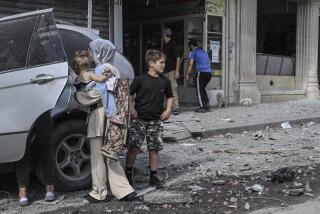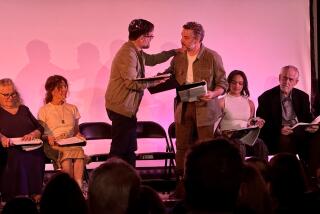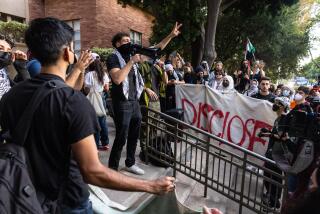Hebron still a divided city 20 years after mosque massacre

- Share via
HEBRON, West Bank — Nidal lives just steps from the mosque where his life changed forever.
It was there, during early morning prayers in 1994, that an Israeli physician named Baruch Goldstein walked in and opened fire, killing 29 Palestinians and wounding 125. Nidal, then 25 and engaged to be married, was shot twice in one arm and once in the back.
The massacre at the Ibrahim mosque at the Tomb of the Patriarchs, a holy site for Muslims, Jews and Christians in the West Bank city of Hebron, occurred 20 years ago this week. Like Nidal, who is unable to work because of his injuries, the city has never been the same.
With 170,000 residents, Hebron is the largest city in the West Bank, and perhaps its most sharply divided.
After the killings set off deadly riots, Israeli authorities moved to separate Hebron’s Palestinian residents from the several hundred Jewish settlers living in the heart of the Old City. Shuhada Street, once a vital commercial corridor, was closed to Palestinians, and dozens of military barricades and checkpoints were established.
Even the biblical burial ground — said to be the final resting place of Abraham, Sarah, Isaac, Rebecca, Jacob and Leah — was partitioned with separate prayer spaces for Muslims and Jews.
Israeli officials say the measures are necessary to protect both sides from persistent inter-communal violence in the city, just 20 miles from the heart of Jerusalem. Palestinians complain that the restrictions have targeted only them and have made the Old City virtually uninhabitable for non-Jews.
A report released last year by the United Nations found that thousands of Palestinians have been displaced from the old quarter in recent years, and those who remain are forced to make long detours through multiple Israeli military checkpoints to access basic services, such as schools and hospitals.
In recent weeks, Palestinian activists have used the anniversary to demand a loosening of restrictions.
“We were victims, and now we’re being banished,” said Issa Amro, who heads a group called Youth Against Settlements that on Feb. 21 led a march calling for Shuhada Street to be reopened to Palestinians.
The initially peaceful protest ended violently, with several dozen young Palestinians burning tires and hurling stones at soldiers, who fired back with tear gas and rubber bullets. Thirteen Palestinians were injured, according to Israeli authorities.
Nidal does not care for protests. He planned to mark the anniversary of the shooting by attending a small ceremony at the mosque, but he also wishes things would return to the way they were. Before the massacre, he could walk 100 feet from his home to the entrance of the mosque without having to pass through a checkpoint, and he could have guests over without Israeli permission.
“The cameras are on us all the time,” Nidal said. He asked to be identified by only his first name because he fears retribution from soldiers for inviting a journalist into his home without authorization.
Nidal had planned to skip prayers that morning 20 years ago. He was working at a construction site at the time and had told his mother that he needed a few extra hours of sleep. But when the dawn call to prayer rang out, he was inspired. He lurched out of bed, put on a suit and went to pray.
It was the holy month of Ramadan, and the mosque was crowded. Nidal was standing in the back of the hall, about to kneel, when the bullets struck him. He was one of the first people shot by Goldstein, a Brooklyn-born physician and member of the ultra-right Kach movement living in a settlement outside Hebron. Goldstein had often talked about his desire to clear Palestinians from land held by the Jewish people during biblical times.
Goldstein was beaten to death in the mosque by Palestinian worshipers; Nidal was taken to a hospital in Ramallah, where he underwent surgery that saved his life. He is now married, with two sons and two daughters, but has limited mobility in one arm and still suffers breathing problems.
The massacre set off a wave of violence that left more than a dozen Palestinians and Israelis dead. A six-month curfew was imposed on Palestinians in the Old City, and Shuhada Street, home to Hebron’s main vegetable markets and bus station, was closed, along with hundreds of Palestinian-owned shops.
A 1997 agreement between Israeli and Palestinian leaders gave Israel official control of Hebron’s old quarter. Palestinian security forces patrol the other 80% of the city.
As part of the agreement, Shuhada Street was briefly reopened in 2000, but it was closed again after the outbreak of the second intifada, when Hebron, a stronghold for the Islamic militant group Hamas, became known as a haven for suicide bombers. One of them blew himself up on Shuhada Street in 2002, killing an Israeli man and his pregnant wife.
David Wilder, an Israeli who moved into a settlement in Hebron 15 years ago, said the ongoing security measures are a direct result of Palestinian violence.
“They declared war on us,” he said. “This is the price they’re paying for that.”
Wilder said that in order to understand today’s dynamic, it is important to look back to the 1929 Arab expulsion of Jews from Hebron, in which at least 67 Jews were killed.
Nearly four decades later, after Israel took control of the city during the 1967 Middle East War, Jews returned to Hebron and forged the first settlement.
“We didn’t conquer and occupy a city,” Wilder said. “We came back home.”
Despite the presence of Israeli soldiers on nearly every block in the Old City, violence remains an almost everyday occurrence. The U.N. found that in 2012 and 2013, about 700 Palestinians were injured by Israeli forces or settlers, and 44 Israelis were injured by Palestinians.
Nidal says he harbors no hostility.
“The person who shot me is dead,” he said. “Why should I carry this anger inside me?”
But he said it is difficult to pass through security points without thinking about the shooting at the mosque.
“It’s a constant reminder,” he said.
More to Read
Sign up for Essential California
The most important California stories and recommendations in your inbox every morning.
You may occasionally receive promotional content from the Los Angeles Times.











